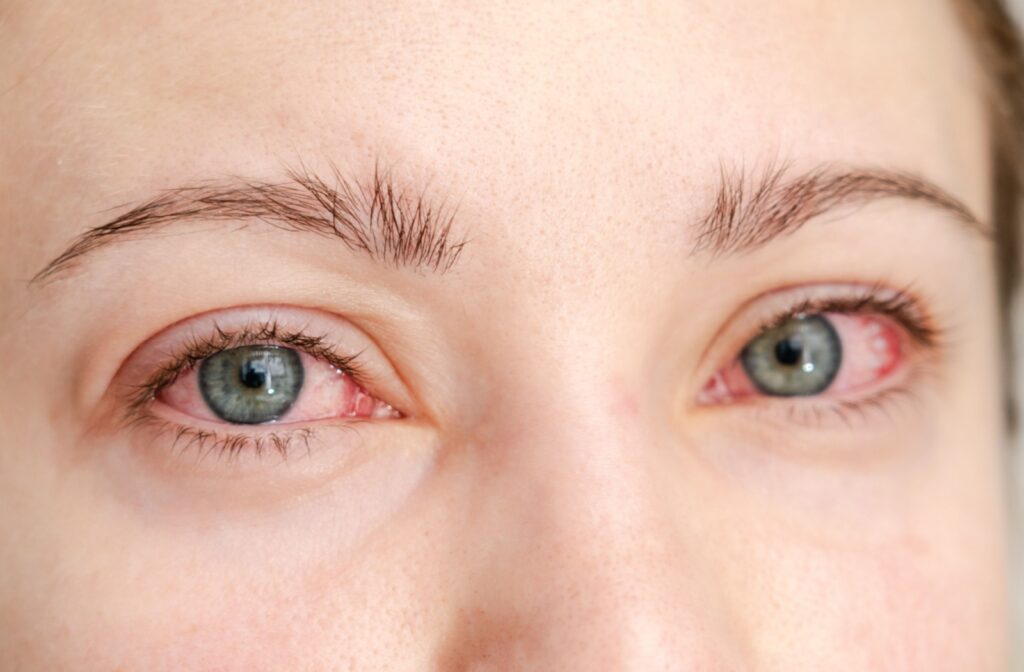Progression in technology has improved the way eye exams detect and manage conditions like ocular rosacea. There’s no cure for ocular rosacea that will eliminate it, but you can take steps and there are treatments available to manage this condition, prevent flare-ups, and halt its progression.
Understanding the symptoms, triggers, and treatment options can make a significant difference in maintaining long-term eye health.
What You Need to Know About Ocular Rosacea
Ocular rosacea is a chronic condition that affects the eyes, leading to symptoms such as redness, dryness, irritation, itching, and a gritty or burning sensation. In some cases, it can also cause light sensitivity and vision problems. Similar to facial rosacea, which appears as redness, bumps, and pustules on the skin, ocular rosacea impacts the eyes and eyelids specifically.
This condition varies in severity. Some individuals experience both facial and ocular rosacea, while others may develop only one form. However, having one does not necessarily mean the other will occur.
Research suggests a combination of genetic predisposition, inflammation, and environmental triggers. Managing this condition often involves a combination of medical treatments and lifestyle adjustments.
Understanding the Impact of Ocular Rosacea
Many individuals with ocular rosacea don’t immediately recognize the symptoms. Initial signs may include dryness, redness around the eyes, and a sensation of irritation, as though something is lodged in the eye. As the condition progresses, burning sensations and light sensitivity may become more noticeable.
Diagnosis typically occurs through an eye exam conducted by an optometrist. Receiving a diagnosis can be overwhelming, as individuals may be concerned about the long-term effects on eye health and daily activities. However, with the right treatment plan, managing ocular rosacea is possible.
A Comprehensive Approach to Treatment
Step 1: Medical Consultation & Diagnosis
Seeking professional medical advice is a key step in addressing ocular rosacea. Optometrists are well-equipped to diagnose the condition, though dermatologists may also provide insight into treatment options. During an eye exam, healthcare providers assess symptoms and inflammation levels to confirm the diagnosis.
Ocular rosacea does not have a single cure, but targeted treatment strategies can help control symptoms and improve eye comfort.
Step 2: Medical Treatments
Addressing inflammation is an essential part of treatment. Intense Pulsed Light (IPL) therapy is often recommended to reduce inflammation in the eyelids and facial skin, which helps manage symptoms at their source.
In addition to IPL therapy, avoiding common triggers such as spicy foods, alcohol, and excessive sun exposure can make a difference. A regimen of warm compresses and eyelid scrubs can also help remove oil buildup and bacteria, reducing irritation and discomfort.
Step 3: Lifestyle & Home Remedies
Lifestyle adjustments play a significant role in managing ocular rosacea. Daily eyelid hygiene can help minimize symptoms. Using warm compresses for several minutes each morning, followed by gentle cleansing with a specialized eyelid scrub, can prevent flare-ups.
Lubricating eye drops may also provide relief by addressing dryness. Staying hydrated and protecting the eyes from environmental stressors contribute to improved comfort over time.
Step 4: Skincare Adjustments
Since ocular rosacea is closely linked to skin inflammation, adjusting skincare routines can support overall treatment. Gentle, fragrance-free facial cleansers and avoiding exfoliants help reduce irritation. Mineral-based sunscreens containing zinc oxide or titanium dioxide provide UV protection, which may prevent symptom flare-ups.
Using hydrating eye creams designed for sensitive skin can also help maintain moisture around the eyes, reducing discomfort and redness.

The Role of Lifestyle Changes in Managing Symptoms
In addition to medical treatments, making a few lifestyle changes may contribute to long-term symptom relief. Stress is a known trigger for rosacea, so mindfulness techniques such as meditation and yoga may be beneficial.
Dietary adjustments, including increasing omega-3 intake from sources like salmon, walnuts, and flaxseeds, have been associated with reduced inflammation and improved eye health.
Prioritizing sleep and staying hydrated are also important factors in managing ocular rosacea. Many individuals notice that symptoms worsen when they are not well-rested, making a consistent sleep schedule a valuable part of symptom management.
Managing Ocular Rosacea Over Time
With consistent treatment and lifestyle modifications, many individuals experience noticeable improvements. Symptoms such as dryness, redness, and irritation often become less frequent, and overall eye comfort increases.
While ocular rosacea requires ongoing management, adopting a structured routine can help reduce flare-ups and maintain eye health. Daily eyelid hygiene, skincare adjustments, and avoiding common triggers all contribute to better long-term outcomes.
Advanced Eye Care at Eyes on Westlake
For those experiencing ocular rosacea, professional guidance can provide clarity and relief. The team at Eyes on Westlake offers personalized care, effective treatment options, and recommendations to help individuals manage their symptoms effectively with a fresh perspective on eye care.
Book an appointment today. A consultation with an optometrist can provide insight into the most suitable treatment plan. Taking proactive steps can lead to improved eye comfort and better management of ocular rosacea symptoms and overall well-being.




